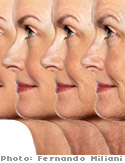
Because nobody should be using the same skincare stuff year after year (skin changes, as you've probably noticed)—and because new and vastly improved products are coming along all the time—here are the upgrades and updates you need to know about now.
For many of us, the way our skin looks in the morning dictates, like the weather, what kind of day we might have. We get out of bed, skip (or stagger) over to the mirror, and peer at our reflection as if we were peering out the window. What did the day blow in? A clear, calm complexion? A shower of breakouts? A mist of fine lines? A gloomy new cumulus of dark spots?We can't control the weather, but we can take charge of our skin. On that front, right now, there is very good news. A great-looking complexion is more achievable than ever, and that doesn't mean you have to devote your life to it or spend a fortune. Moisturizers have improved: Hyaluronic acid, immensely helpful in carrying moisture to the skin, has made formulas more smoothing and effective. Active ingredients like retinol, antioxidants, and peptides intensify the potency of all kinds of products, says Mary Lupo, MD, clinical professor of dermatology at Tulane University School of Medicine. And many of the newest formulas penetrate better because ingredients are delivered in smaller molecules.
To help you in your quest for brighter horizons complexion-wise, we talked to top dermatologists across the country about what it takes to get gorgeous skin, and came up with this straightforward, thorough, easy-to-follow, bottom-line guide for every age.
No matter your age, try our decade-by-decade guide to beautiful skin!
You've heard of adult acne. But how is it different from teenage acne? It's not. "Acne is acne. And you're an adult," says Ranella Hirsch, MD, president-elect of the American Society of Cosmetic Dermatology & Aesthetic Surgery. The reasons you may be breaking out are varied: the hormonal changes of pregnancy, perimenopause, menopause, or stress. Treat acne with a good over-the-counter product containing benzoyl peroxide, which kills bacteria (try Clinique Acne Solutions Emergency Gel-Lotion, $13.50), and salicylic acid, which unclogs pores (try Clean & Clear Advantage Acne Spot Treatment, $6.50), says Mary Lupo, MD, clinical professor of dermatology at Tulane University School of Medicine. If it doesn't clear up in three months, see a dermatologist. Lupo recommends the CoolTouch laser, because it mitigates fine lines, helps with acne scarring, and reduces active acne by shrinking the oil glands. Retinoids also help clear up acne, and have the added benefit of reducing fine lines, stimulating collagen, and improving discoloration due to sun damage.
If you're between 30 and 60, persistent red patches—small, dilated, broken blood vessels—on your cheeks, nose, or chin may indicate that you have rosacea. It's not pretty but can be treated with topical antibiotics—such as MetroGel and Rosac—and oral antibiotics. The Aura-i laser works well to zap broken blood vessels, says Jeanine Downie, MD, coauthor of Beautiful Skin of Color. For mild to moderate rosacea, you need six treatments, a month apart, and then three treatments a year for maintenance. There's no downtime. Because rosacea is directly related to cumulative sun exposure, it's critical to wear a broad-spectrum sunscreen that protects against both UVA and UVB rays. Besides the sun, triggers include stress, hormone fluctuations, alcohol (especially red wine), spicy or thermally hot foods and drinks, and even exercise, says Downie. (She advises patients to drink ice water when they work out, to cool the face.) It helps to use gentle products and to avoid irritating your skin by scrubbing.




